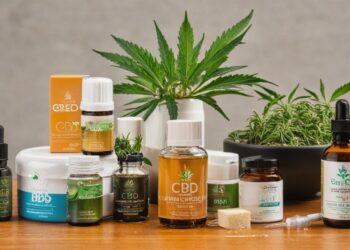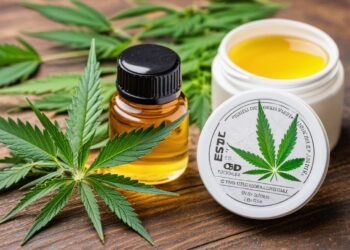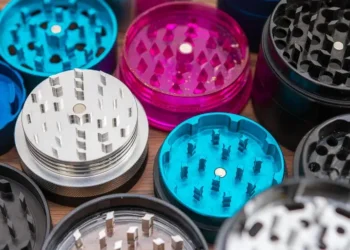Introduction
A Revolutionary Trend: CBD’s Rising Popularity
Picture this: a world where people seek natural remedies to improve their overall well-being, finding solace in a plant-based compound that offers promising health benefits. Enter CBD, the rising star of the wellness industry. Over the past few years, CBD has garnered immense attention and gained a dedicated following.
From celebrities to soccer moms, it seems like everyone is talking about it. But what exactly is driving this surge in popularity?
The Importance of Unveiling the Science Behind CBD
Beyond its trendiness lies a crucial aspect that often goes unnoticed: understanding the science behind CBD. While many are drawn to its potential benefits, it is vital not to get caught up in mere hype and marketing buzzwords.
By unraveling the scientific intricacies behind why and how CBD works within our bodies, we can truly appreciate its potential and make informed decisions about incorporating it into our lifestyles. To fully comprehend the significance of CBD’s popularity, we must acknowledge that it transcends simple wellness trends or passing fads.
It represents a fundamental shift towards reclaiming control over our health choices while embracing nature’s gifts. The increasing interest in natural alternatives demonstrates society’s growing desire to break free from synthetic drugs with potential side effects.
CBD has managed to capture widespread attention due to its diverse range of purported benefits, including pain relief, anxiety reduction, improved sleep quality, and more recently recognized applications such as epilepsy management. However, despite these claims gaining significant traction among users worldwide, blind acceptance without comprehending the underlying science can hinder progress.
By delving into the scientific realm of CBD’s actions within our bodies, we can navigate through misleading information and separate fact from fiction. Understanding how this phytocannabinoid interacts with our endocannabinoid system lays the groundwork for making informed choices when integrating it into our wellness routines.
Furthermore, this knowledge empowers individuals to advocate for responsible regulation and quality control within the CBD industry. In an era where misinformation can spread like wildfire, it is our responsibility to shed light on the scientific foundations of CBD’s popularity.
Only by embracing this mindset can we truly appreciate its potential and leverage its benefits to lead healthier lives. So, let us embark on a riveting exploration of the science behind CBD and unravel the mysteries that lie within this remarkable compound.
What is CBD?
A Plant-Based Wonder
When it comes to the world of wellness, CBD has become a buzzword in recent years. But what exactly is CBD? Short for cannabidiol, CBD is a naturally occurring compound found in the cannabis plant.
It’s important to note that CBD is typically derived from hemp plants, which contain low levels of THC (tetrahydrocannabinol), the psychoactive compound that gives marijuana its characteristic “high.” Unlike THC, CBD doesn’t produce any mind-altering effects. While CBD may be trendy now, its history dates back centuries.
Ancient civilizations like the Egyptians and Chinese were among the first to recognize the therapeutic properties of cannabis plants, using them for various medicinal purposes. However, it wasn’t until recently that scientists began unraveling the secrets of this plant-based wonder.
Differences between CBD and THC
The Yin and Yang of Cannabis Compounds
One common question surrounding CBD is how it differs from THC. As mentioned before, while both compounds are derived from cannabis plants, they have distinct characteristics. While THC is known for its psychotropic effects responsible for inducing a euphoric feeling or “high,” CBD offers a different experience altogether.
CBD works with your body’s natural endocannabinoid system (ECS) to promote balance and well-being without any intoxicating effects. In fact, studies suggest that it may even counteract some of THC’s effects by reducing anxiety or paranoia that can sometimes accompany marijuana use.
It’s important to emphasize that legal hemp-derived CBD products must contain less than 0.3% THC by law in many countries and regions. This ensures that you can safely experience the potential benefits of CBD without worrying about any unwanted psychoactive effects.
Various Forms of CBD Products Available
From Tinctures to Topicals: Finding Your Perfect Fit
CBD comes in a variety of forms, making it accessible and enjoyable for everyone. Let’s explore some common types of CBD products you can find on the market. Tinctures: These are liquid extracts that usually come with a dropper for easy administration.
They allow you to consume CBD orally by placing a few drops under your tongue or mixing them with food or beverages. Edibles: CBD-infused goodies have gained popularity, with options ranging from gummy bears to chocolate bars.
They offer a delicious and discreet way to incorporate CBD into your daily routine. Topicals: Creams, lotions, and balms enriched with CBD are excellent for targeting localized discomfort or soothing irritated skin.
Simply apply them directly to the affected area for potential relief. Vaping: For those who prefer inhalation methods, vaping offers a quick and efficient way to experience the effects of CBD.
However, it’s crucial to choose high-quality vape products from reputable sources. Capsules: If you prefer a convenient and pre-measured option, capsules provide an easy way to incorporate precise doses of CBD into your wellness regimen.
Remember that everyone is different, so exploring different forms may help you find what suits you best. It’s always recommended to start with low doses and gradually increase as needed while monitoring how your body responds.
The endocannabinoid system: a key player
Subtitle: Unraveling the Mysteries within Us In order to understand how CBD works in the body, we must first delve into the fascinating world of the endocannabinoid system.
This intricate network of receptors and signaling molecules plays a crucial role in maintaining balance and harmony within our bodies. Often referred to as ECS, it is involved in regulating various physiological processes such as mood, appetite, pain perception, immune response, and sleep patterns.
The endocannabinoid system consists of three main components: endocannabinoids, receptors, and enzymes. Endocannabinoids are naturally occurring molecules produced by our bodies that resemble cannabinoids found in cannabis plants.
These include anandamide and 2-arachidonoylglycerol (2-AG). The two primary receptors associated with this system are CB1 and CB2 receptors.
Interaction between CBD and receptors in the body
Subtitle: Unlocking the Receptor Codes CBD’s interaction with these receptors is what makes it so intriguing.
Unlike THC, which binds directly to CB1 receptors to produce psychoactive effects, CBD has a more indirect influence on these receptor sites. It modulates their activity without directly attaching to them.
When CBD enters our body, it stimulates the production of natural endocannabinoids while also inhibiting their breakdown by enzymes like fatty acid amide hydrolase (FAAH). This results in increased levels of anandamide circulating in our system, which can have profound effects on our overall well-being.
CB1 receptors: found mainly in the brain and central nervous system
Subtitle: Opening Doors to New Possibilities CB1 receptors are primarily found in regions of the brain associated with cognition, memory processing, emotions, and pain perception.
When activated by cannabinoids like THC or anandamide, CB1 receptors can modulate neurotransmitter release, leading to various physiological effects. In the context of CBD, its interaction with CB1 receptors is more complex.
Rather than directly binding to these receptors, CBD indirectly influences them by altering their shape or sensitivity. This modulation can have a wide range of effects on brain function, including potential therapeutic benefits in conditions like epilepsy, anxiety disorders, and neurodegenerative diseases.
CB2 receptors: primarily located in immune cells and peripheral tissues
Subtitle: Guardians of Our Immune Fortress CB2 receptors are predominantly found in immune cells throughout our body’s peripheral tissues. Their activation is associated with anti-inflammatory and immunomodulatory effects.
Interestingly, CBD has a higher affinity for CB2 receptors compared to CB1 receptors. By interacting with CB2 receptors, CBD may help regulate immune responses and reduce excessive inflammation associated with conditions such as autoimmune disorders or chronic pain.
This immunomodulatory property of CBD opens up new possibilities for harnessing its potential therapeutic benefits. Understanding the interplay between CBD and these receptor sites provides valuable insights into how this compound works within our bodies.
The endocannabinoid system acts as a regulator of homeostasis, influencing various physiological processes essential for our well-being. By modulating the activity of CB1 and CB2 receptors through its unique mechanisms, CBD holds promise as a natural remedy for an array of health conditions while offering an alternative approach to traditional medications with potentially fewer side effects.
Health Benefits of CBD
Pain Management and Anti-Inflammatory Properties
One of the most well-known benefits of CBD is its ability to alleviate pain and reduce inflammation. For individuals suffering from chronic pain conditions like arthritis or fibromyalgia, CBD has emerged as a promising natural alternative to traditional pain medications.
Studies have shown that CBD interacts with receptors in the brain and immune system, reducing inflammation and blocking pain signals. This makes it an appealing option for those looking to manage their pain without relying on opioids, which can be addictive and come with a range of negative side effects.
Anxiety and Stress Reduction
Anxiety disorders affect millions of people worldwide, causing immense distress in their daily lives. Fortunately, CBD has shown significant potential in managing anxiety-related symptoms.
By interacting with serotonin receptors in the brain, CBD helps regulate emotions and reduce feelings of anxiety. It promotes a sense of calmness without causing any psychoactive effects commonly associated with THC (the compound responsible for the “high” feeling).
Subtitle: A Natural Remedy for Insomnia
Sleep disturbances are a common problem faced by many individuals today. Whether it’s difficulty falling asleep or staying asleep throughout the night, insomnia can have a detrimental impact on one’s overall well-being.
Here is where CBD steps in as a natural remedy for sleep issues. By addressing underlying factors such as anxiety or chronic pain that often contribute to sleeplessness, CBD can help promote better sleep patterns.
CBD’s Role in Epilepsy Treatment
Epilepsy is a neurological disorder characterized by recurring seizures that result from abnormal electrical activity in the brain. Traditional treatment options for epilepsy often involve strong medications with severe side effects.
However, research on using CBD for epilepsy treatment has shown promising results, particularly in reducing the frequency and intensity of seizures. It is worth noting that CBD has gained significant attention for its potential effectiveness in treating seizures, especially in children, who often struggle with limited treatment options.
By exploring the various health benefits of CBD, it becomes evident that this natural compound holds immense potential for enhancing our well-being. Whether it’s alleviating chronic pain or managing anxiety-related symptoms, CBD’s effectiveness is gaining recognition among both researchers and individuals seeking alternative treatments.
Moreover, its role in epilepsy treatment presents a ray of hope for patients struggling with seizures. As the scientific community continues to investigate and understand CBD further, more discoveries are sure to emerge, expanding our knowledge about this remarkable cannabinoid’s capabilities.
The Legality of CBD
Regulations Surrounding Hemp-Derived vs Marijuana-Derived CBD
When it comes to the legality of CBD, things can get a little hazy (pun intended). One crucial factor that determines the legal status of CBD is whether it is derived from hemp or marijuana.
The distinction lies in the levels of THC present in the plant. Hemp-derived CBD contains less than 0.3% THC, while marijuana-derived CBD can have higher concentrations.
In the United States, the 2018 Farm Bill legalized hemp and its derivatives at the federal level. This means that CBD derived from hemp is legal under federal law, as long as it adheres to certain regulations and has THC levels below 0.3%.
However, individual states have their own laws regarding cannabis products, so it’s essential to check your state’s regulations before purchasing or using CBD. On the other hand, marijuana-derived CBD is subject to stricter regulations due to its higher THC content.
While some states have legalized recreational or medical marijuana use, others still consider it illegal. It’s crucial to be aware of these variations and understand that marijuana-derived CBD may only be legally accessible in specific locations or with a prescription.
Differences Based on Geographical Location (International Perspective)
The legality of CBD also varies significantly on an international scale. Some countries adopt a more progressive approach towards cannabis in general, allowing both hemp-derived and marijuana-derived CBD products for medical or recreational purposes.
Countries like Canada and Uruguay have fully legalized cannabis at the national level. However, many countries still classify all forms of cannabis as illegal substances.
In regions such as Asia and the Middle East, possessing even small amounts can result in severe penalties including imprisonment or hefty fines. Other countries have implemented more lenient policies where only specific medicinal uses are allowed.
It’s important to note that even in countries where CBD is legal, there may still be restrictions and regulations in place. These can include labeling requirements, dosage limitations, or the need for a prescription.
If you plan to travel with CBD internationally, it’s crucial to research the specific laws of your destination country beforehand to avoid any legal complications. The legality of CBD is a complex issue that depends on various factors such as the source (hemp vs marijuana) and geographical location.
Understanding the regulations surrounding hemp-derived versus marijuana-derived CBD is essential for consumers to ensure they are compliant with local laws. Whether you’re in the United States or traveling internationally, it’s always prudent to stay informed about the legal landscape pertaining to CBD products.
CBD Myths Debunked
Addressing misconceptions about getting “high” from using CBD
Many people have a misconception that using CBD will get them high, just like marijuana. However, this is far from the truth.
Unlike THC, the psychoactive compound found in cannabis, CBD does not have any intoxicating effects. It does not alter your perception or leave you feeling euphoric.
In fact, CBD is non-intoxicating and has been found to counteract the psychoactive effects of THC when taken together. So, if you’re worried about getting high from using CBD products, you can put those concerns to rest.
Clearing up doubts about addiction or dependency on CBD
Another common myth surrounding CBD is that it can lead to addiction or dependency. Let me assure you that this is simply not the case.
Numerous studies have shown that CBD is not addictive and does not create a craving for more of the substance. In fact, some research suggests that CBD may even help individuals overcome addiction by reducing cravings and withdrawal symptoms associated with substances like opioids or nicotine.
CBD works by interacting with our body’s endocannabinoid system, which plays a crucial role in regulating various physiological processes such as mood, pain perception, and appetite. By modulating these systems without causing dependence or tolerance buildup typically associated with addictive substances, CBD offers a promising alternative for individuals seeking relief without the fear of becoming addicted.
The Science Behind It: How Does CBD Really Work?
To truly understand why these myths are just that – myths – it’s important to dive into the science behind how CBD works in our bodies. When we consume CBD products like oils or tinctures, it interacts with our endocannabinoid system (ECS).
This system includes receptors located throughout our bodies – in our brain, organs, immune cells, and peripheral tissues. CBD primarily interacts with two types of receptors in the ECS: CB1 receptors, which are mainly found in the brain and central nervous system, and CB2 receptors, primarily located in immune cells and peripheral tissues.
It modulates the activity of these receptors without directly binding to them, leading to various therapeutic effects. By understanding the mechanism of action behind CBD’s interaction with our ECS, it becomes clear that getting high or developing an addiction is simply not a concern.
CBD works to promote balance within our bodies without causing any harmful or addictive effects. So rest assured, you can use CBD products for their potential health benefits without worrying about any negative consequences.

How to Choose Quality CBD Products
Importance of Third-Party Lab Testing for Purity and Potency
When it comes to choosing CBD products, one of the most crucial aspects to consider is third-party lab testing. This process involves sending samples of CBD products to independent laboratories for comprehensive analysis. The purpose?
To ensure that the product’s purity and potency meet the claims made by the manufacturer. Third-party lab testing eliminates bias and provides consumers with unbiased results they can trust.
The importance of third-party lab testing cannot be overstated. Without it, consumers would have no reliable means to verify the contents and quality of CBD products.
These tests not only check for the presence of CBD but also determine if there are any harmful contaminants, such as pesticides, heavy metals, or residual solvents. By opting for products that have undergone rigorous third-party testing, you can have peace of mind knowing that you’re using a safe and effective product.
Understanding Different Extraction Methods Used by Manufacturers
The extraction method employed by manufacturers plays a significant role in determining the quality and effectiveness of CBD products. There are several extraction methods used in the industry, each with its pros and cons. One common extraction method is CO2 extraction, which utilizes pressurized carbon dioxide to extract cannabinoids from hemp plants.
This method ensures a pure and high-quality end product while minimizing the risk of contaminants. Another widely used technique is ethanol extraction, where ethanol (a type of alcohol) is used as a solvent to extract cannabinoids from hemp plant material.
Ethanol extraction is known for its efficiency in extracting a broad spectrum of cannabinoids but requires additional purification steps to remove impurities. There’s solventless extraction, which involves techniques like heat and pressure (such as rosin pressing) or ice water hash separation methods.
These methods are often favored by those who prefer more natural and organic CBD products. However, it’s important to note that solventless extraction methods may result in lower yields and may not be as efficient as other extraction methods.
When choosing CBD products, it’s worth understanding the different extraction methods used by manufacturers. This knowledge can help you make an informed decision based on your preferences for purity, potency, and overall product quality.
When selecting CBD products, prioritize those that have undergone third-party lab testing to ensure their purity and potency. Remember that these tests provide unbiased results and help verify the claims made by manufacturers.
Additionally, familiarize yourself with the various extraction methods utilized by manufacturers to determine which approach aligns with your preferences for a high-quality CBD product. By investing the time to research and choose wisely, you can confidently embark on your journey exploring the benefits of CBD while ensuring you’re using safe and effective products.
Potential Side Effects and Precautions with CBD
Unwanted Effects: Separating Fact from Fiction
When it comes to potential side effects of CBD, it’s important to separate fact from fiction. While CBD is generally well-tolerated by most individuals, a few mild side effects have been reported. These may include dry mouth, drowsiness, and changes in appetite.
However, it’s crucial to note that these effects are typically mild and temporary. It is advisable to start with a lower dose of CBD and gradually increase as needed to minimize the risk of experiencing any adverse reactions.
Drug Interactions: Proceed with Caution
CBD has the potential to interact with certain medications due to its influence on liver enzymes responsible for drug metabolism. When taking medications that carry a grapefruit warning or require close monitoring for interactions, exercise caution when using CBD. It is recommended to consult with a healthcare professional before incorporating CBD into your routine if you are taking prescription medications.
Quality Control: Ensuring Safety and Efficacy
Ensuring the safety and efficacy of CBD products goes beyond considering potential side effects and drug interactions. Quality control measures are essential in the rapidly expanding market of CBD products. It’s crucial to choose products from reputable manufacturers who provide third-party lab testing results for purity and potency verification.
This helps guarantee that the product contains what it claims on the label while adhering to safety standards.
Conclusion
As we delve into the science behind CBD’s growing popularity, we can appreciate its potential benefits as an alternative remedy for various health conditions. While research on CBD is still ongoing, initial findings show promising results in areas such as pain management, anxiety reduction, epilepsy treatment, among others.
However, like any supplement or medication, it is important to be aware of potential side effects and take necessary precautions. Start with a low dose, monitor your body’s response, and consult with a healthcare professional if you have any concerns or are taking other medications.
Additionally, ensuring the quality and safety of CBD products through proper labeling and third-party lab testing is paramount. Overall, CBD offers an exciting avenue for exploring natural remedies that may enhance our well-being.
With continued research and education, we can unlock its full potential while prioritizing safety, efficacy, and responsible use. So seize the opportunity to explore this rapidly expanding field of natural wellness with CBD!












